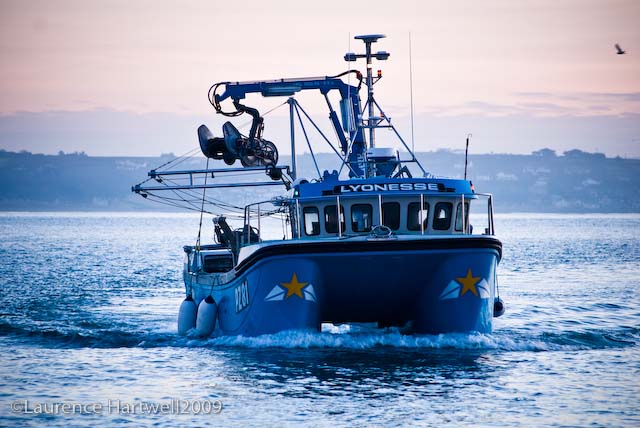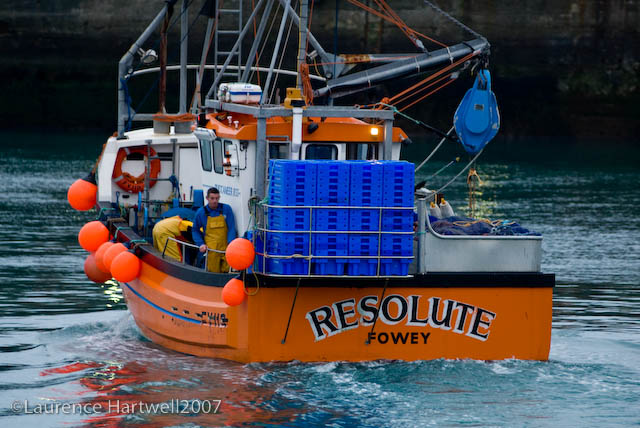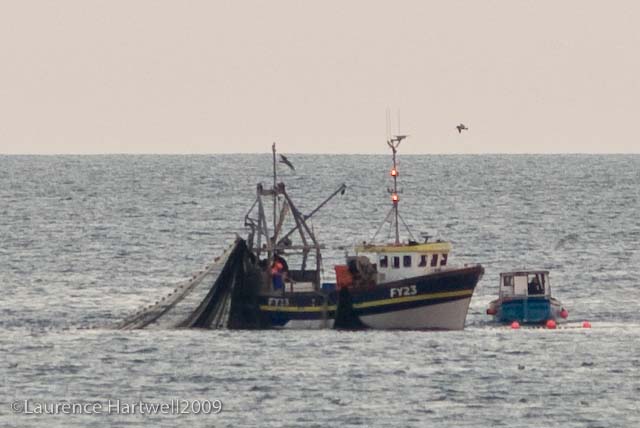129 voted they would continue to buy line caught mackerel, 4 objected!
This survey should give some hope for local hand line fishermen who were outraged - rightly so as they were being dragged into a fight that had no relevance to them and their method of fishing for mackerel. Eventually, the MMO and MSC came out in support of the hand line fishers here in the south west along with fish chefs like Nathan Outlaw saying he would continue to keep mackerel o the menu as it was caught locally by hand line.
Though the Cornishman newspaper managed to find one unhappy reader sufficiently incensed to pen a letter of protest about the ring net fleet operating out of Newlyn - read on:
This letter appeared in the local Cornishman newspaper last week.
Hopefully, most of the readers of the Cornishman are better informed and have a wider understanding of the ring net method of fishing than D Howard of Newlyn.
Below, are extracts from the well documented assessment procedure and accreditation process from the MSC - the body that manages every certified stock in the world.
It took over five years of hard work and research to establish the fishery with PGI (Protected Geographical Indication) status in 2009 - Cornish Sardines - there is a web site dedicated to the Cornish Sardine Management Association where information on the method and fish can be found.
The fishery was subsequently accredited with MSC status - as a sustainable fishery in 2010. Cornwall’s iconic sardine fishery has passed its Marine Stewardship Council assessment and been certified as a sustainable and well-managed fishery. The fishery – which recently gained European geographic designation as ‘Cornish Sardines’ can now add the MSC ecolabel to its products.
The Cornish sardine fleet currently consists of 6 vessels using ring nets and a further 10 vessels catching sardines with drift nets. Boats sail mainly from Newlyn and Mevagissey and stay in inshore waters – within six miles of land. The sardines they catch are significantly larger than the minimum size allowed and are proving popular with restaurants and retailers.
Jon Harman, Development Director for Seafish says: “Seafish helped fund the development of a tool to help assess the stock status of the data-deficient Cornish sardine fishery. We recognised the need to trial a tool, to an international standard, for fisheries facing challenges in the amount of data available. This was an important stepping stone to MSC certification and we are pleased that Cornish sardines have now been approved to MSC standard after being reviewed by this new process.”
Catch levels of pilchards into Newlyn and Mevagissey from Defra records have been less than 100 tonnes between 1999 and 2003, while latest figures indicate catches of around 870 tonnes between January and September 2009 (MFA Monthly returns of sea fisheries statistics for England, Wales, Scotland and Northern Ireland, September 2009). A rough estimate of the maximum fishing mortality would therefore be less than 0.15, i.e. less than 50% of natural mortality estimates (0.33, as used by ICES). It is therefore highly likely that fishing mortality is below FMSY (reference point from the World Summit on Sustainable Development (WSSD)). The ICES stock evaluation in 2008 mirror the results of the PELGAS surveys, highlighting a decline in biomass due to bad recruitments in 2004 and 2005, but good recruitments in 2006 and 2007 which should subsequently increase biomass levels. The opinion of an underexploited stock is also supported by the ICES working group report, which shows that the demographic structure of sardine is not truncated, with all age groups represented in the population
The Performance of the Cornish Sardine fishery in relation to MSC Principles 1, 2 and 3 is summarised below:
MSC Principle Fishery Performance Principle 1: Sustainability of Exploited Stock Overall: 80.0 Principle 2: Maintenance of Ecosystem Overall: 84.3 Principle 3: Effective Management System Overall: 83.9
The fishery attained a score of 80 or more against each of the MSC Principles. The MRAG Americas Assessment Team, therefore, recommends that the Cornish Sardine Ring Net and Drift Net Fishery pass certification according to the Marine Stewardship Council Principles and Criteria for Sustainable Fisheries.
Following this Recommendation of the assessment team, and review by stakeholders and peer-reviewers, a determination is hereby made by the MRAG Americas Certification Committee (MACC) to certify the fishery.
In either case the current state of this stock is good and therefore there is low risk for the assessment of status for the Cornish sardine.
Going back to the letter - which is obviously at odds with the data and stock research carried out by the MSC - there are also a number of other inaccurate observations. These are more heinous as they are both misleading and indeed totally inaccurate.
The ring net boats involved are the catamaran,
 |
| Lyonesse... |
 |
| the Asthore... |
 |
| the Resolute... |
 |
| the White Heather... |
 |
| and the Little Pearl - the net she works is 203m long - some simple maths determines that when the net is 'shot' it encircles an area of 64m² (that's the diameter of 205 divided by pi or 22/7) |
It should be obvious, from the size of these boats, that they are incapable of working a net 'miles long' as is stated in the letter.
The video below shows the fleet fishing close to Newlyn early one evening a few years ago...
If you look carefully you can see the full extent of the net being worked.
 |
| Pathway and Lunar Bow |
These are among the biggest kind of 'ring net' type boat in the UK fleet - though the boats seldom work this kind of net (purse seine) today preferring mid-water trawls to catch pelagic fish like mackerel and herring. Even in their case....
"The fish are then pumped or brailed aboard the vessel. A large purse seine can be as long as 1 kilometre and 200 metres deep."
The staff at the local MMO office would also be most interested to know that there are "miles of gill nets" being used in the Bay. To the best of my knowledge no inshore fishermen has ever caught cormorants or any diving birds in their nets - where most of the boats work the Bay is too deep!
Lastly, this shot was taken near Battery Rocks not so long ago. Cormorants, a plenty!

